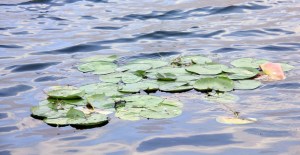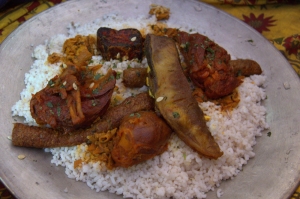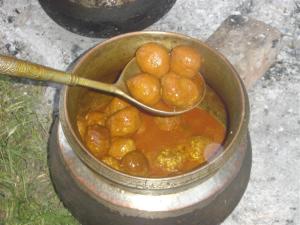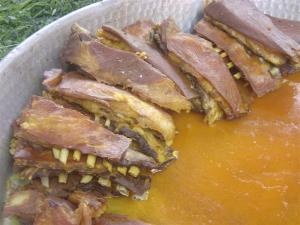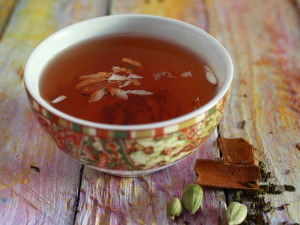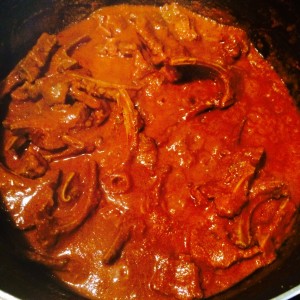“Agar firdous baroye zameen ast, hami asto hami asto hami ast” – If there is paradise on earth, its here, its here, its here.
A Persian couplet that describes the beauty of Kashmir valley. Its also been referred to as paradise on earth. But today through my blog I shall take you through an extraordinary culinary journey of this beautiful valley. Often underrated, Kashmir has some of the most delectable delicacies on offer. The most simplest of all cuisines, Kashmiri cuisine involves minimum use of spices and most of them are common in all dishes. The emphasis lies mainly on how every cut of meat is used and the techniques of cooking, the same would apply for the vegetarian fare.
Let me start with a brief history of Kashmiri cuisine and the external influences that led to the evolvement of the cuisine as we see it today. Kashmir was originally known as Kashyap Mar or the holy land of the Great Rishi (Saint) Kashyap. Thats how Kashmir got its name. The valley was inhibited by Kashmiri Pundits also referred to as Saraswat Brahmins and were know to be the descendants of the saints. So the actual cuisine had been in existence over hundred years. However the change happened when the Uzbeks invaded Kashmir in the 15th century and bought the Muslim influence on the cuisine, giving it a more finesse touch by introducing meat and other ingredients. However there is a slight contradiction here as according to my research and speaking to a few culinary historians I learnt that the Kashmiri Pundits were heavy meat eaters themselves but its still not clear whether this change happened pre Uzbek invasion or post. Although the Kashmiri pundits avoid the use of onion and garlic in their food preparations even for the meat dishes. Saying that neither the Kashmiri Pundits nor the Muslims consume beef. Apart from the Uzbeks, Kashmiri Cuisine also had a notable influence from the Persians and the Afghans.
Kashmiri food until a few years ago was mainly confined to homes. One would rarely see a restaurant or an eatery of any other kind serving this cuisine in India or abroad. However there were a few places to savour these delicacies in Kashmir itself. But now there are quite a few good restaurants serving authentic Kashmiri cuisine in various parts of the Indian subcontinent. I wouldn’t be able to say the same for eateries outside of India.
Kashmiri cuisine can be divided into two categories broadly. The cuisine of the Kashmiri pundits and the cuisine of the Kashmiri Muslims. Though not much of a difference in names although there is a difference in the ingredients used. The Kashmiri Pundits typically avoid using onion, garlic and even tomatoes in their cooking. I believe that its quite subtle and light preparation with more emphasis on the actual flavours from the meat and vegetable and of course being complemented with freshly ground spices. The main spices used are Kashmiri chilli powder, ginger powder, saffron, hing (asafoetida), saunf (aniseed) and a unique garam masala called Var or Veri. This is a blend of spices and is compressed in a cake form. Its mixed with oil and then sun dried. Its supposed to be a great flavour enhancer. The medium of cooking is usually Desi ghee (clarified butter) or mustard oil and a lot of thick yoghurt is used to give body to the dishes.
A few famous dishes are
Dum Oluv or Dum Aloo – these are potatoes that are simmered in spicy gravy flavoured with Hing. The spice factor is due to addition of Kashmiri chillies and this dish is bright red in colour again due the chilli factor.
Gugji Rajma – This a red kidney bean stew cooked with turnips.
Monji Haak – Kohlrabi cooked in mustard oil and flavoured with veri (kashmiri spice cake) and hing.
Tschaman Kaliya – Its a paneer curry which is flavoured with saunf (aniseed), green cardamom, veri (spice cake) and surprisingly cooked with milk. a very subtle and light dish yet very delicious.
I shall cover the Non-Vegetarian fare in the Wazwan section of the blog but i need to mention a few unique chutneys that are made in Kashmir and often savoured during the Wazwan. “Muji Chatin” or Radish chutney with is made with radish and yoghurt and there is another version where its just grated and sauteed with mustard oil flavoured with red chilli powder, green chillies and walnuts. “Doon Chetin” or Walnut chutney is made with walnuts, yogurt, dried mint, green chillies, red chilli powder and fresh coriander. “Gand chetin” or Onion chutney is made with sliced onions which are soaked in vinegar and flavoured with dried mint leaves and red chilli powder.
Moving on to the epitome of the Kashmiri cuisine – Wazwan which is a spectacular banquet served and i can’t find any other cuisine I could compare it to. Lavish and ultimate is all could say . Wazwan was influenced mainly by the Kashmiri Muslims. As i said before the difference between the Pundits and Muslims cuisine was that the Pundits never used onions and garlic while the Muslims used garlic and only wild onions also known as “Pranth” in their cooking.
Wazwan is a banquet that serves 36 courses. The dishes are cooked by “Vasta Waza” or the head chef and “wazas” or the assistant chefs. Wazwan has a very high significance culturally among the Kashmiri Muslims and is treated with a lot of respect. A typical Wazwan has people sitting in groups of 4 and the meals are served on a “Trami” which is a large engraved copper plate and the meals are shared. The meal traditionally starts with washing hands. This is done by passing jugs (tash-t-nari) filled with water among the guests. The trami is then filled with a heap of rice and the rest of the courses follow. I wont be able to list all the 36 dishes but will try to cover most of them.
The meal usually start with kabab which is made from lamb or goat mince and and skewered over charcoal. I believe this the only form of starter that served through the entire meal apart from kaanti kebab.
Kaanti Kabab – made with the fillet of goat or sheep marinated with yogurt, spices and garlic and is fried rather than being grilled.
Lahabi Kabab – these flattened kababs which are made from a blended mince of the kabab that are served as the first course and the mince of the rista and goshtaba- cooked in a yoghurt gravy.
Rista – these are meatballs cooked in a red gravy. The red colour in kashmiri cuisine is usually derived from either the Kashmiri chillies or “cockscomb flower” also known as “ratanjot”. The meat is derived from either sheep or goat and then pounded very carefully on a wooden block. The perfect meatballs are achieved through maintaining the right temperature throughout the pounding process and laced with kidney fat.
Palak Rista or Waza Palak – This dish is same as the above with the addition of Spinach.
Goshtaba – the same meatballs as rista are used in this recipe however the gravy has a yoghurt base and its very mildly spiced as compared to rista. Even the dumplings are slightly flattened while making the rista as compared to goshtaba.
Yahni – this dish is made with sheep or goat shanks and cooked in a yogurt based gravy.
Methi Maaz – this dish is cooked with the off cuts and trimmings of the animal and flavoured with methi or fenugreek leaves.
Tabak Maaz – this dish is prepared using sheep or goat ribs which is cooked in milk along with spices and aromatics and then covered in a yogurt based batter and cooked again on dum by sealing the pot with dough and placed on charcoal for about an hour. Another similar dish is called “Kabargah” wherein the entire process is the same but instead of cooking it on dum its flash fried before serving.
Dhaniwal Korma – Goat or sheep curry thats cooked with loads of fresh coriander and yoghurt.
Marchwangan Korma – Goat or sheep korma cooked with fiery hot Kashmiri chillies and spices.
Aab Gosht – Sheep or Goat ribs cooked in a milk based gravy. This dish clearly brings out the Persian influence onthe cuisine.
Doudha ras – this is meat cooked in a sweet milk gravy.
Rogan Josh – A so called signature dish of the Kashmiri Cuisine, this dish has introduced people to Kashmir. Persian in influence this dish was introduced by the Mughals. Prepared in clarified butter, without the addition of onions, garlic or tomatoes by the Kashmiri Pundits while the Kashmiri Muslims add wild onions. One of the most popular dishes on every Indian restaurant menu all over the world. How authentic? is the question to ask .
Waza Kokur – Twice cooked whole chicken marinated and deep fried then cooked again in a spicy gravy that evenly coats the chicken.
Nadir Yahni – The vegetarian fare of the Wazwan. Lotus stem roots cooked in yoghurt gravy with spices. Another version of this is served in the Wazwan with the addition of spinach called Nadir palak.
Haak – Kashmiri greens simply cooked in mustard oil and kashmiri chillies.
I have not mentioned individual spices in the above dishes as Kashmiri cuisine uses very few spices and they are used across the board for all the above dishes with the addition and subtraction of a few.
Not to mention Kashmiris do consume seafood in their diet as well. Trout I believe is the only form of seafood consumed. Trout is farmed in Pahalgam and interestingly was introduced by Frank J Mitchel from Scotland in the early 1900.
Phirni – Kashmiris don’t boast of desserts in their cuisine however this humble dessert forms a part of the Wazwan, ground rice cooked in milk until thick custard consistency and garnished with edible silver leaf and assorted chopped nuts.
Tea is a very important beverage in the Kashmiri culture. Served during all important occasions and festivals. Kawah is served during marriages, its a green tea made with saffron, spices and almonds. Noon chai is also another quite popular salted kashmiri tea. You can read more about Kashmiri teas on my previous blog on “Nashta” the great Indian Breakfast.
I have always felt that Kashmiri cuisine is quite unique in its approach as compared to it counterpart cuisines. Subtle yet leaves a punch on your tongue. With the minimum use of ingredients I feel the emphasis is more on how every part of the animal is used to give different textures to the Wazwan.
I leave you with this “authentic” recipe of Rogan Josh. Do give it a try and you could compare it to restaurant version for yourselves.
Recipe Rogan Josh
1 kg Lamb or Goat (Use the leg meat, ask your butcher to cut it in dices with the bone.)
200 gms thick yoghurt.
150 ml Ghee or clarified butter
12-15 whole kashmiri red chillies
5 green cardamom
4 cloves
3 black cardamom
1 tsp fennel powder
1/2 tsp ginger powder
couple of pinch of hing (asafoetida)
salt to taste
Method
1. Boil the red chillies for 10-15 mins. Drain and make a smooth paste. Add a little water if required.
2. Wash the meat and drain the excess water.
3. Heat ghee in a pot, add the hing, and the whole spices. Stir for a few minutes and add the meat. Stir on a high heat till the meat pieces are brown. Add the powdered spices, along with salt, yoghurt and the chilli paste. Stir fry for another 15 mins and add 2 cups of hot water. cover with lid and cook on low heat for 45 mins -1hr or until the meat is completely tender.
4 . Serve hot with parathas or rice.
Photo credits – maverickbird http://wp.me/p3hiyv-19G

